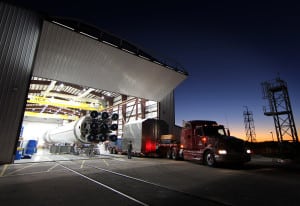Latest News
[Via Satellite 10-06-2015] Spaceflight Services announced Sept. 30 that the company purchased a Falcon 9 rocket from SpaceX to conduct a launch entirely for rideshare missions. SpaceX will assist in the launch and getting the Falcon 9 into the correct position. After that, Spaceflight will deploy the satellites onboard and place them in their correct orbits.
By managing an entire rocket, Spaceflight is able to control the launch schedule and provide access to more useful orbits for SmallSats compared to rideshare missions where a primary satellite dictates the path for all other spacecraft. Curt Blake, president of Spaceflight Services, told Via Satellite that SpaceX will receive revenue through Spaceflight’s purchase of the Falcon 9, and Spaceflight will generate revenue from filling the rocket. The launch is slated for 2017, and around 80 percent of the available space is already booked with customers.
Spaceflight had been eyeing launch vehicles to purchase for dedicated rideshare missions for at least a year. The company discussed the possibility of buying and stocking a rocket with small satellites in October last year at the Hosted Payload and SmallSat Summit (HPSS). In an Oct. 1, 2015 interview with Via Satellite, Blake explained the decision-making process that culminated in the recent purchase.
“We made the decision to proceed with the purchase of a launch vehicle because the feedback from our customers confirmed a strong need for this service,” he said. “We wanted to provide our customers regular, predictable access to a popular orbit. By talking to our network of customers we knew timing the launch to the second half of 2017 allowed a large number of those customers to have their satellites ready for launch.”
Spaceflight’s Falcon 9 mission, named the 2017 Sun Synch Express, will deploy more than 20 satellites for commercial customers and government-sponsored scientific research originating from six different countries. As the name suggests, the 2017 Sun Synch Express mission will deliver satellites to a sun-synchronous orbit inLow Earth Orbit (LEO), which is a common destination for Earth imaging satellites. Blake said the rocket is capable of taking approximately 6 metric tons to LEO, and that planning the mission is “like playing a game of Tetris” to fit current customers in while optimizing space and mass for additional satellites. The mission’s manifest includes satellites ranging from a 5kg 3U CubeSat up to a 575kg satellite.
In the past, Spaceflight has facilitated the addition of SmallSats to Falcon 9 Dragon missions to the International Space Station (ISS), along with other supply runs. Over time, this relationship matured into procuring an entire rocket. Curt said an additional factor was that the Falcon 9 is accessible for U.S. government customers.
“We do foresee purchasing more Falcon 9s in the future,” said Blake, adding that Spaceflight is not limiting its purchases to exclusively to Falcon 9 rockets. “Given that SpaceX is a U.S.–based company, using their rockets eases the process of coordinating launches and meets some of the restrictions and regulations our clients face. Additionally, we’re excited about the potential of the Falcon 9 becoming a reusable rocket. We intend to offer annual missions to a low earth, sun synchronous orbit beginning in 2017 and to Geosynchronous Transfer Orbit (GTO) beginning in 2018.”
Blake said Spaceflight looks forward to using a previously flown Falcon 9 rocket in the future. He said Spaceflight plans to launch one to two dedicated rideshare missions per year.
SpaceX now has more than 60 missions manifested with its Falcon 9 and Falcon Heavy launch vehicles. Between now and 2018, Spaceflight has more than 135 satellites on its manifest.
Get the latest Via Satellite news!
Subscribe Now